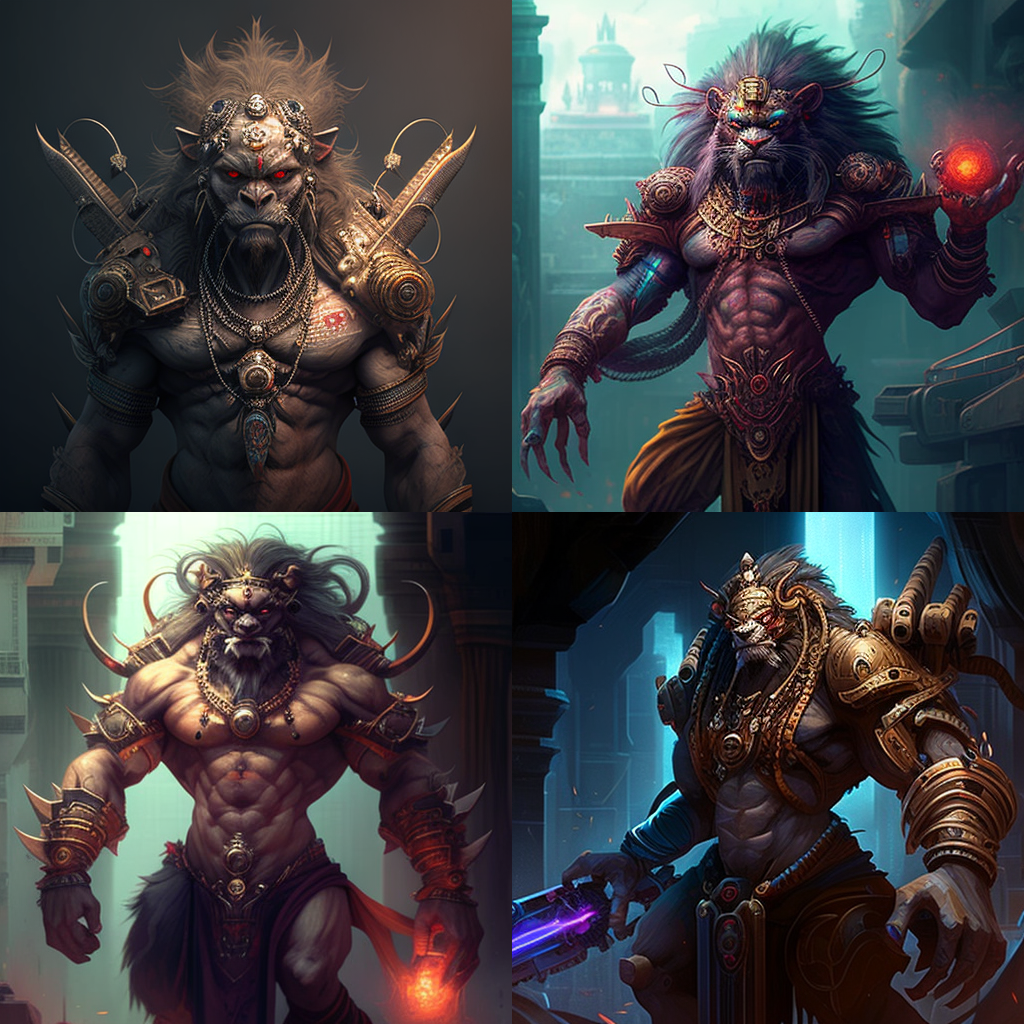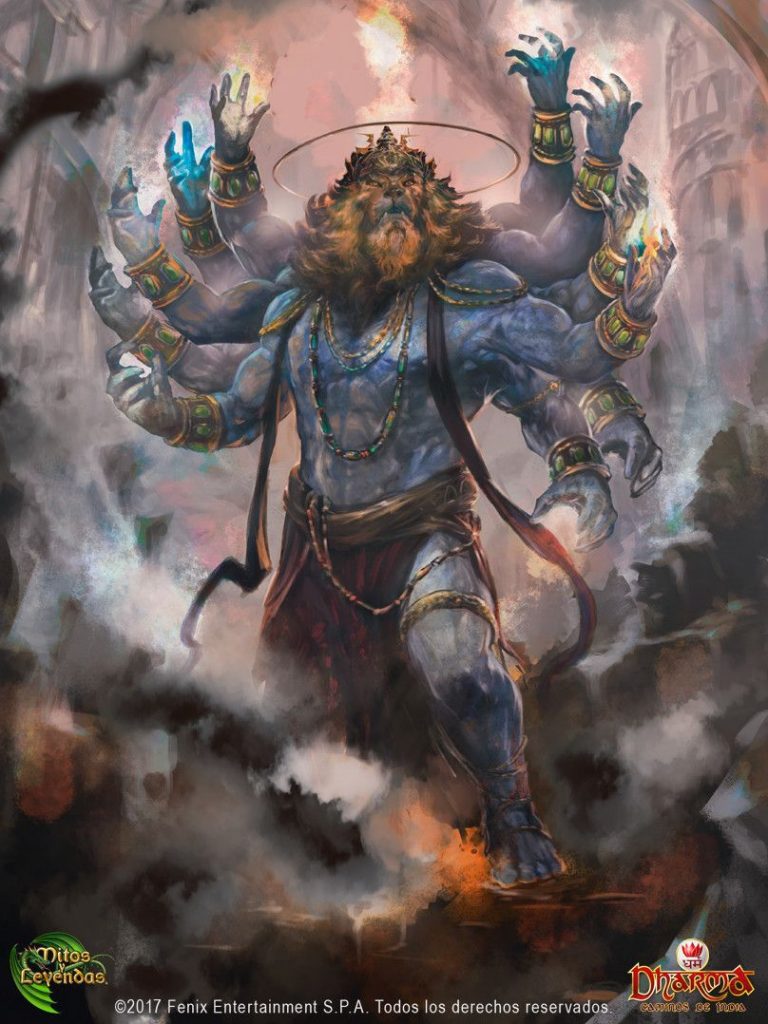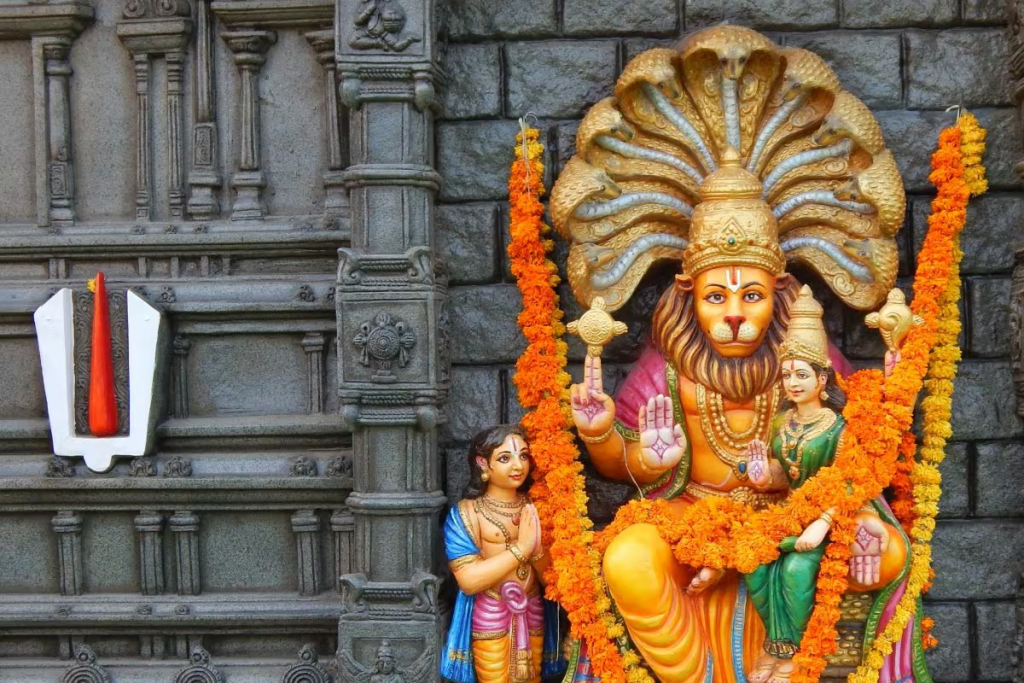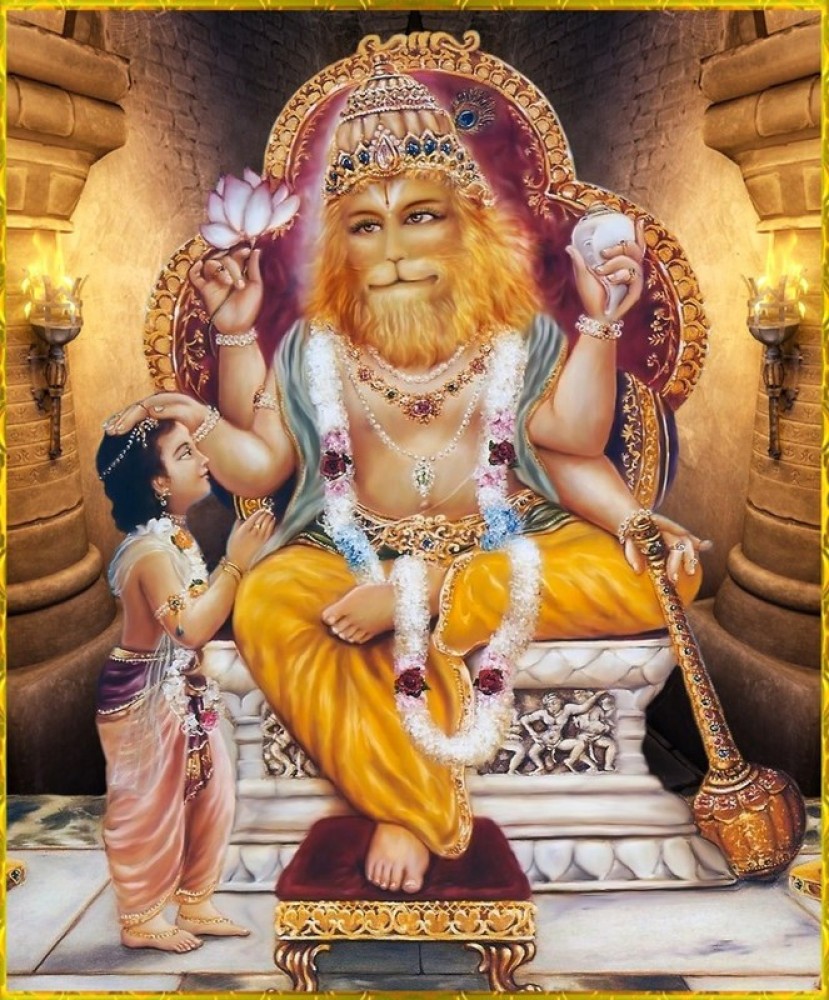Garjantam garjayantam nija-bhuja-patalam sphotayantam hatantamdipyantam tapayantam divi bhuvi ditijam kshepayantam kshipantamkrandantam roshayantam dishi dishi satatam samharantam bharantamvikshantam purnayantam kara-nikara-shatair divya-simham namami
Lord Narasimha roars ferociously and also moves others to roar aloud. He has a large number of arms and tears down the demons to pieces while confronting them on the way. He moves about tormenting the demonic descendants of Diti. With his powerful hands he scatters them and throws hither and thither. He cries out in great anger and sustains, protects and nourishes the cosmic beings. I revere and pay obeisance to the Lord who has assumed the form of a transcendental lion.

Narasimha is known to be one of the most powerful incarnations of Lord Vishnu, often portrayed in Hinduism as half human and half lion. This fierce deity is believed to bring balance and protection to the lives of his devotees. For centuries, artists and artisans across India have depicted this deity in various forms of art.
text and images above from this website: https://thptlaihoa.edu.vn/stunning-collection-of-full-4k-narasimha-images-over-999-images/
Narasimha (Sanskrit: नरसिंह, lit. ‘man-lion’, IAST: Narasiṃha), sometimes rendered Narasingha, is the fourth avatar of the Hindu god Vishnu.[3] He is believed to have incarnated in the form of a part-lion, part-man being to kill Hiranyakashipu, to end religious persecution and calamity on earth, thereby restoring dharma.[1][4] Narasimha is often depicted with three eyes, and is described in Vaishnavism to be the God of Destruction; he who destroys the entire universe at the time of the great dissolution (Mahapralaya). Hence, he is known as Kala (time) or Mahakala (great-time), or Parakala (beyond time) in his epithets. There exists a matha (monastery) dedicated to him by the name of Parakala Matha at Mysuru in the Sri Vaishnava tradition.[5] Narasimha is also described as the God of Yoga, in the form of Yoga-Narasimha.
https://en.wikipedia.org/wiki/Narasimha
_______*******_______*******
But there’s another mythical being from Vajrayana Buddhism with the same name:
22. Shambhala King
Narasiṃha (mi’i seng ge), an emanation of Nīvaraṇaviṣkambhin.Narasingha (Tib. Miyi Senge) (2027-2127) Ruling by the Wheel, Holding the Conch
from https://tibetanbuddhistencyclopedia.com/en/index.php?title=Narasi%E1%B9%83ha
Vajrayana Buddhism has a list of kings or rulers of Shambhala starting with seven “Dharma Kings” Dharmarajas (Tib. Chogyal) from 900 B.C. to the year 276 A.D. Then come 25 Kalki (Tib. Rigden) that all but one reign for 100 years. The next change of rulership happens in 2027 when this, the 22nd Kalki monarch, takes his place, three years from now! After that, come three more with the end of Kali Yuga happening some 300 to 400 years from now, but we are at a major juncture as 2027 marks the transition from the 21st Kalki king, Aniruddha, “he who binds the three worlds” who has been ruling since 1927 to Narasimha.
In the Indo-Tibetan Vajrayana Buddhist tradition, there are thirty-two Kings of Shambhala, a mythical kingdom.
https://tibetanbuddhistencyclopedia.com/en/index.php?title=Kings_of_Shambhala
The first notable king of Shambhala, King Suchandra was the one who requested teaching from the Buddha. In response to his request, the Buddha gave the first Kalachakra root tantra. By practicing the Kalachakra the whole of Shambhala became an enlightened society, with Suchandra as the ruler. He was followed by an additional six Dharmarajas (Truth Kings). His eighth successor, Manjushri Yashas, was the first to be known as the Kalki King (Tib. Rigden, wylie: rigs ldan), to be followed by 24 more leading up to the present day.
More on the 25 Kalki…
The most recent 25 of the 32 Kings of Shambhala are known as Kalki kings (Tib. Rigden, wylie: rigs ldan), meaning “Holder of the Castes.” The Kalki King is said to reside upon a “Lion Throne” in Kalapa, the capital city of the Kingdom. The Kalki are holders of the Kalachakra (Wheel of Time), which are the teachings of Buddha Shakyamuni passed down from the original seven Dharmarajas of Shambhala.
https://en.wikipedia.org/wiki/Kings_of_Shambhala
They have an image for him, but he’s not a half-lion, that one is from Hinduism; but my thought is, nevertheless, the imagery is different but the name is the same, and in both, emanations of either God as Vishnu or one of the eight bodhisattvas designated as “regents-of-our-world” , called Nīvaraṇaviṣkambhin (he who blocks hindrances) or Sarvanīvaraṇaviṣkambhin (he who blocks all hindrances).
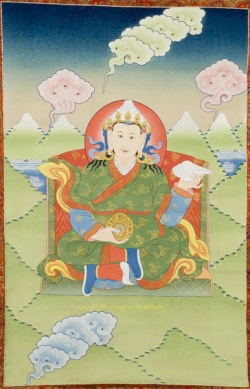
He is referenced as being considered an “emanation” of a powerful bodhisattva. Narasiṃha (mi’i seng ge), an emanation of Nīvaraṇaviṣkambhin
https://tibetanbuddhistencyclopedia.com/en/index.php?title=Sarvanivaranavishkambhin
Sarvanīvaraṇaviṣkambhin is a bodhisattva revered in Mahāyāna Buddhism. He is one of the Eight Great Bodhisattvas with Mañjuśrī, Samantabhadra, Avalokiteśvara, Mahāsthāmaprāpta, Ākāśagarbha, Kṣitigarbha and Maitreya. His name means “He who blocks (viṣkambhin) all of the hindrances (sarva nivāraṇa).”
https://en.wikipedia.org/wiki/Sarvaniv%C4%81ra%E1%B9%87avi%E1%B9%A3kambhin
…
In Tantric Buddhism, he is usually placed in the lineage of Amoghasiddhi Buddha, one of the five Dhyani Buddhas, more rarely of Akshobhya Buddha.
The mantra of this great bodhisattva to remove all obstacles and disturbances mentioned in the Vairocana-sūtra, is as follows:
namaḥ samantabuddhānāṃ/ aḥ/ sattva hitābhyudgata/ traṃ/ traṃ/ raṃ/ raṃ/ svāhā
https://tibetanbuddhistencyclopedia.com/en/index.php?title=Sarvanivaranavishkambhin
He “blocks hindrances”. The Vishnu avatar of the same name came down to block a hindrance so to speak. The main purpose of his incarnation as half man-half lion was to kill a certain demon who had mighty spells protecting him so that he could not be killed on land, nor in the water, nor in the air, and not by man nor beast nor by any weapon either. A very powerful protection spell he had going, so ‘God’, as Vishnu means just that but from a Hindu perspective, incarnated himself as this bad-ass lion-person-hybrid, neither man nor beast, that ended pulling the demon up on his lap, so he wasn’t on the ground, nor in the water, nor in the air, and then killed him, not with a weapon, but with his bare claws ripping the demon apart from the abdomen. Quite a gory, albeit highly revered image commonly depicts this act.
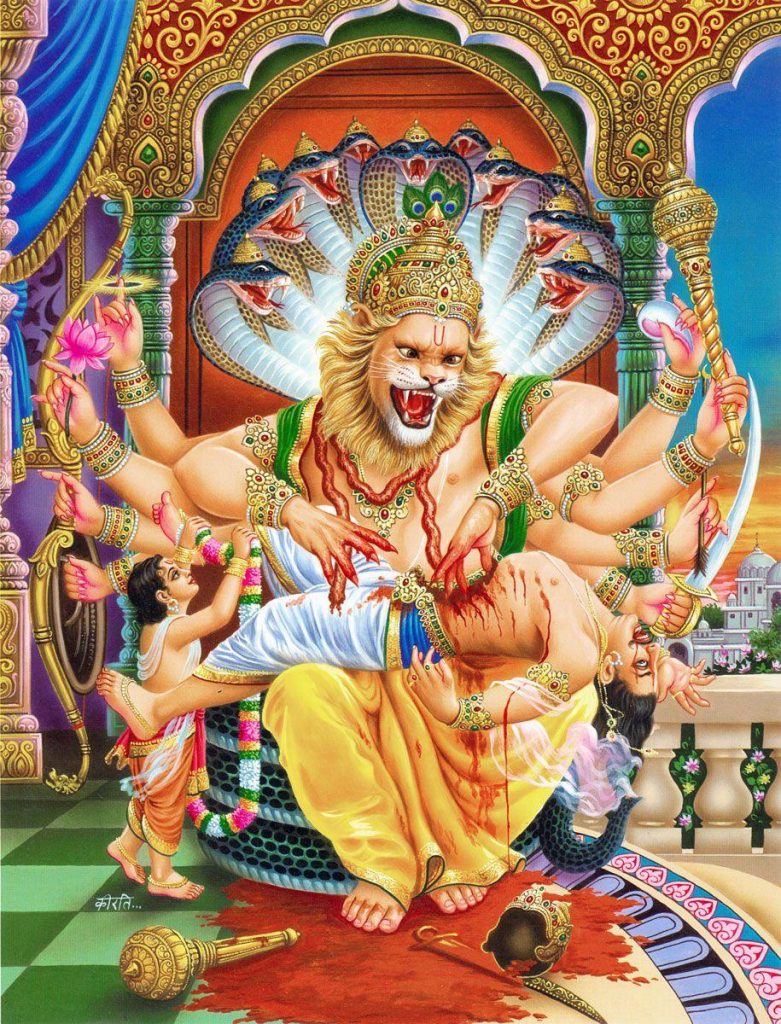
I just now looked up the story, my spiel above was from memory, but it’s much more involved than that,, wow! neither day nor night, neither inside nor outside, by neither man, demi-god, demon nor beast….
Narasimha iconography shows him with a human torso and lower body, with a leonine face and claws, typically with the asura Hiranyakashipu being disemboweled and killed by him in his lap. The asura king was the powerful elder brother of the evil Hiranyaksha, who had been previously killed by Vishnu as Varaha, and thus hated the latter.[8] Hiranyakashipu gained a boon from Brahma due to which he could not be killed during the day or night, inside or outside the house; neither in the sky nor on land nor in Svarga nor in Patala, by any weapon, nor by humans, deities, demons, or animals.[9] Endowed with this boon, he began to wreak chaos and havoc, persecuting all the devotees of Vishnu, including his own son Prahlada.[1][9][10] Vishnu, cognisant of the asura’s boon, creatively assumed a hybrid form that was neither human nor animal as a lion in the name of Narasimha, and Narasimha disemboweled and killed Hiranyakashipu and at the junction of day and night, at the threshold of his palace, which was neither inside nor the outside, upon his lap, and with his claws.[1] Narasimha is known primarily as the ‘Great Protector’ who specifically defends and protects his devotees from evil.[11] The most popular Narasimha myth is the legend of his protection of his devotee Prahlada, and the killing of Prahlada’s wicked father and demon Hiranyakashipu.[12]
https://en.wikipedia.org/wiki/Narasimha
So that’s the namesake Hindu God incarnation story that goes with the new ruler of Shambhala scheduled to come into office in 2027!
Food for thought!
Namaste

